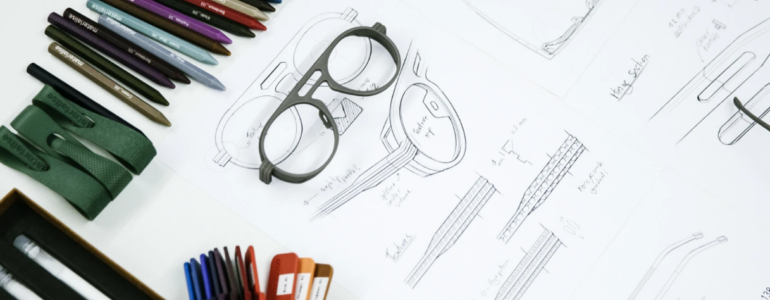5/06/23

How can you prepare for your first foray into 3D-printed eyewear?
Here’s what you need to know to create a 3D-ready collection.
If you’re considering 3D printing eyewear for the first time, it’s important to start by understanding how this way of manufacturing works; do that, and your design is already one step closer to perfection.
Selective laser sintering, or SLS for short, is one of the most commonly used 3D printing technologies for eyewear. And honestly, it’s not hard to see why when you understand what it does — it offers designers incredible versatility, accuracy, and unparalleled design freedom.
But what it is, is mesmerizing.
It’s the birth of an idea — your idea — coming together layer by layer in a bed of fine powder. Millions of particles fusing together, etched into existence by a highly accurate laser. That irrepressible sense of excitement and impatience as you see nothing become something.
There’s something undeniably beautiful about the whole process, but it’s the benefits that truly matter. You’ll print only what you need, meaning unsold stock is no longer an issue, while the production itself is also less wasteful compared to machining acetate. You’ll use only the material you require for your design, with the remaining powder being carefully recycled, ready to bring another idea to life.
3D printing’s design freedom is a big attraction, yet it’s important to know that there are still rules you must follow when designing your frames. Constraints such as the minimum wall thickness ensure your design is printable and has the intended functionality. If the walls are too thin, the part may become brittle or break during production. The design of your frame can also impact the post-processing steps, such as coloring or achieving the desired surface finish.
So, how can you ensure your collection will turn out as you envisaged? Our best advice is to be flexible in your design — plan for a potential range of thickness in your frames, and our designers will work with you to optimize it for production.
Understandably, to create a 3D-printed collection, you’ll need 3D files. In most cases, STEP or Parasolid (.xt) files are fine, as these can be converted to the STL files required for printing. How you create them really comes down to personal preference — typically, whether you like to work with CAD vs. mesh. A bit of trial and error with the various available software packages is a good way to find the one that works for you.
If you prefer, you can design your collection in 2D and either bring it to us or have another 3D design expert convert it for you. In fact, collaborating on this step has plenty of advantages and ensures that whatever you create is ready for printing from the start. One particularly beneficial service we offer in these situations is correcting the design to ensure the lens’s position, size, and sphere is correct and accounted for in the 3D file before we print it.
Just like any other manufacturing method, your design impacts your price per unit when it comes to 3D printing — and it goes beyond the material you choose. In eyewear, the factor with the most influence on cost is volume. Thicker frames, for instance, use more material and take up more space in the print bed, meaning you’ll print fewer at a time — make your frames thinner, and you’ll use less material and print more at once. It’s all very logical.
Interestingly, what sets 3D printing aside is that complexity is completely free. You can design in and print intricate details from the start, using only the materials you need. This results in a final product that would only be possible after several additional steps with traditional manufacturing, if at all. Keep this in mind and take advantage of it in the design process — it’s good to get creative.
When evaluating your bottom line, it’s important to look beyond your design and identify the intangible cost benefits of choosing 3D printing too. Key among these is your ability to print in batches of one, automatically eliminating one of the biggest threats to eyewear brands: unsold stock. By printing in small series or on-demand, you can avoid that high-risk investment up front and limit your environmental impact with unsold stock.
The final look and feel of your 3D-printed eyewear will never be an afterthought, but you may be surprised to know how early in the design process you should consider it. That’s because everything from the material you choose to the intricacies of your frame influences the finishing and post-processing steps. So, how can you design around this? Our advice is:
• Research the characteristics of your chosen material, and plan accordingly
• Maintain a consistent thickness — transition to thinner points gently and gradually
• Avoid overly thin points — these can be damaged or blunted in post-processing